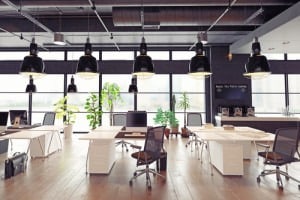
A rapidly expanding co-working facility needed a flexible climate-control system that could adapt to ever-changing levels of occupancy.
Name of Organization: The Reserve
Industry: Business services
Location: Minneapolis, MN
Opportunity or Challenge Encountered: Co-working spaces have become the popular place for entrepreneurs, remote workers, and other independent workers to camp out, drawn by the sites’ ambiance, flexibility, locations and opportunities for social interaction. The capacity of a typical co-working site can vary from day to day, making energy management a challenge for such facilities. Such was the case with The Reserve, a suburban co-working space based in the Twin Cities, Minnesota region.
When they decided to open their third location, The Reserve’s management sought to manage energy costs across its growing base of sites, enabling tenants to enjoy a zone-controlled experience. “With our members at The Reserve, the environment is the most important thing to them. And when you peel it back, and say, what does this squishy thing called the environment really mean? You’re too hot, you’re too cold; you’re not going to feel productive.” says Mary Bartlett, chief operating officer of The Reserve.
How This Opportunity or Challenge Was Met: The company turned to 75F Dynamic Airflow Balancing, which helped manage, in real time, more than 50 zones across a typical facility. The solution includes individual zone sensors that record and report temperature and humidity levels every 60 seconds. Then, proprietary algorithms analyze and combine the sensor data with local weather forecasts in order to send the optimal control strategy to the central control unit, a case study relates.
See also: Watching the power grid, in real-time
The central control unit relays instructions to incrementally move smart dampers a few degrees at a time, creating even temperatures throughout the building. The system creates a continuous dialog with The Reserve’s roof-top units, ensuring they work together to reduce energy usage while improving the occupant experience.
Facility managers at The Reserve have insights and control across all their offices and locations. Temperatures can be remotely scheduled and adjusted, and the health of the system can be monitored to ensure maximum efficiency.
Benefits from This Initiative: Despite the space being twice as large, energy costs are less than half of the first location, Bartlett states. “Our Edina space is about half of what the Woodbury space is, yet my utility bills are almost exactly the same. SO I know I’m getting more efficiency out of the systems that we have in place because it isn’t taking much more energy to heat and cool a building almost twice the size of the original one.”
The challenge is keeping every office comfortable, in real-time, says Bartlett. “We’ve been able to create microclimates, and I can monitor that office to see if it’s too hot or too cold. is it a meeting room that’s at capacity with the doors closed? Then I know what temperature it’s at, then I can take various actions on the dashboard to help me control that space, without ever having to go into the meeting room and disturb them.”



























